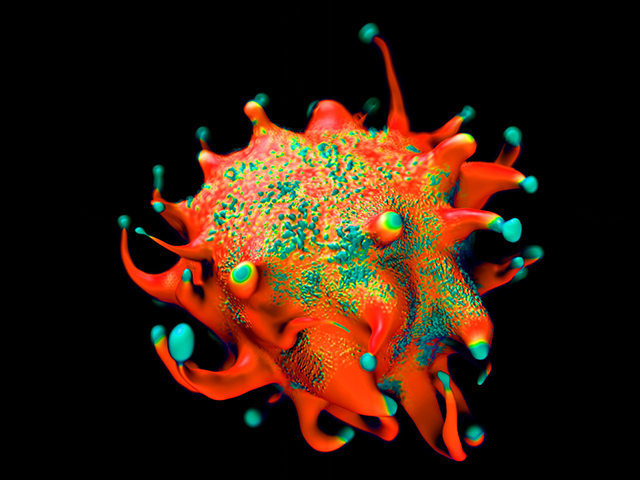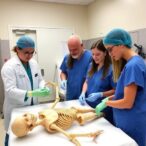Translocations are chromosomal “cut and paste” errors that drive many lymphomas, a type of blood cancer and the sixth most common form of cancer overall. This includes mantle cell lymphoma, a rare but aggressive subtype diagnosed in about one in every 100,000 people each year.
A study by researchers at the Centre for Genomic Regulation (CRG) in Barcelona, has shown a new way translocations promote cancer. The translocation most typically found in mantle cell lymphoma drags a powerful regulatory element into a new area of the human genome, where its new position allows it to boost the activity of not just one but 50 genes at once.
The discovery of this genome rewiring mechanism shows the traditional focus on the handful of genes at chromosomal breakpoints is too narrow. The study also greatly expands the list of potential drug targets for mantle cell lymphoma, for which there is no known cure.
“We did not expect to see a single translocation boosting the expression of almost seven percent of all genes on a single chromosome,” said CRG researcher Renée Beekman, PhD. “The ripples of disruption are much bigger than expected, and also identify new cancer driver genes, each of which represents a new potential therapeutic target.” Beekman is corresponding author of the team’s published paper in Nucleic Acids Research, titled “Translocations can drive expression changes of multiple genes in regulons covering entire chromosome arms.” In their paper the team stated, “In summary, our findings can have a major impact on understanding the role of ultra-long-range interactions in shaping the gene expression landscape in physiological and pathophysiological conditions, such as early tumor formation, representing an important new mechanism in health and disease.”
Translocations are known to spark cancer by altering the activity of the genes near the breakpoints where chromosomes snap and rejoin. For example, a translocation can accidentally cut a gene in half, silencing its activity, or create new hybrid proteins that help promote cancer. It is commonly known that structural variants (SVs) such as translocations can play a key role in disease development, particularly in malignancies,” the authors wrote. “Chromosomal translocations have largely been implicated in tumor development…However, beyond the consequences of aberrant gene expression near the breakpoint, their effects remain underexplored.”
Mantle cell lymphoma is a lymphoid malignancy that accounts for five to ten percent of all NHLs, the authors explained. In mantle cell lymphoma, a piece of chromosome 14 swaps places with a piece of chromosome 11. A gene regulatory element called the IGH enhancer, which normally boosts the activity of antibody production in healthy B cells, lands right beside CCND1, a gene which helps cells divide. The enhancer treats CCND1 as if it were a gene encoding for antibodies, boosting its activity and fueling the disease. “MCLs frequently display the t(11;14)(q13;q32) translocation, which leads to the juxtaposition of the IGH enhancer next to the CCND1 proto-oncogene, a positive regulator of cell cycle,” they further wrote.
Previous research has shown that boosting CCND1 expression alone is insufficient to kickstart the formation of mantle cell lymphoma. “…CCND1 overexpression alone is not sufficient to drive tumor formation, suggesting that the effect of the translocation could be broader than previously appreciated,” the team further noted. “For their reported study the team used MCL as a model, to investigate the interplay between translocations, chromatin architecture, and gene expression.
The scientists first created translocations in cells in a dish. They used CRISPR to replicate the exact chromosome break seen in patients. “We built a system to generate translocations in healthy B cells,” said co-author Roser Zaurin, PhD. “Because these are engineered cells, we can carry out experiments that are technically or ethically unfeasible with patient tissues, making it a really useful early disease model.”
The team’s experiments revealed that over fifty genes along the entire chromosome 11 were much more active after the translocation took place. The translocation affected gene activity across 50 million base pairs, a significantly larger space than previously thought. “…we demonstrate a clear link between the translocation-induced transcriptional alterations and genome organization, with genes most susceptible to change expression forming pre-existing ultra-long-range interactions spanning 50 megabases,” they stated.
![Engineered mantle cell lymphoma cells [Roser Zaurin/Centro de Regulación Genómica]](https://www.genengnews.com/wp-content/uploads/2025/08/Low-Res_FISH-T4.4-zoom-2-300x300.jpg)
How DNA folds inside the engineered cells revealed why the translocation affects so many genes at once. “DNA loops inside cells. It’s what brings two segments of DNA that are far away from each other in two-dimensional space closer together in three-dimensional space,” explained first author Anna Oncins, PhD. “The translocation drags the strong IGH enhancer into a preexisting loop, placing it in a privileged position of control, enabling it to have a widespread impact on dozens of genes at the same time.”
Intriguingly, most of the genes affected by the enhancer were not silent to begin with. The IGH enhancer simply dials their activity up. “We show that translocation-induced effects mainly represent expression enhancement of genes already active prior to translocation formation, highlighting the importance of the epigenetic state of the cell in which this initial hit occurs,” the investigators pointed out. This biological nuance may explain why the same translocation can have different consequences in different cell types or stages of development. Only genes which were already active are boosted.
The findings could lead to new strategies for the early-stage detection of mantle cell lymphomas. “Because the enhancer mainly supercharges genes that were already active in the very first B cell that acquires the swap, epigenetic profiling of at-risk cells could spot dangerous combinations before a mantle cell lymphoma appears,” Beekman suggested. The authors further wrote, “…our study provides a clear set of genes to be explored for their oncogenic effects in MCL, as a solid basis to design better murine tumor models and therapeutic strategies in the context of MCL that is so far considered incurable.”
The authors of the study next plan on studying exactly how the newly identified genes contribute to the initiation and progression of lymphoma. Understanding and eventually interrupting the effects of the chromosomal translocation could yield broader, more durable therapies for mantle cell lymphoma and other types of cancers driven by chromosome swaps. “Future research will reveal similar mechanisms by which ultra-long-range interactions shape the gene expression landscape in healthy tissues, and show how a broad range of SVs can influence this phenomenon to drive tumor development.”



